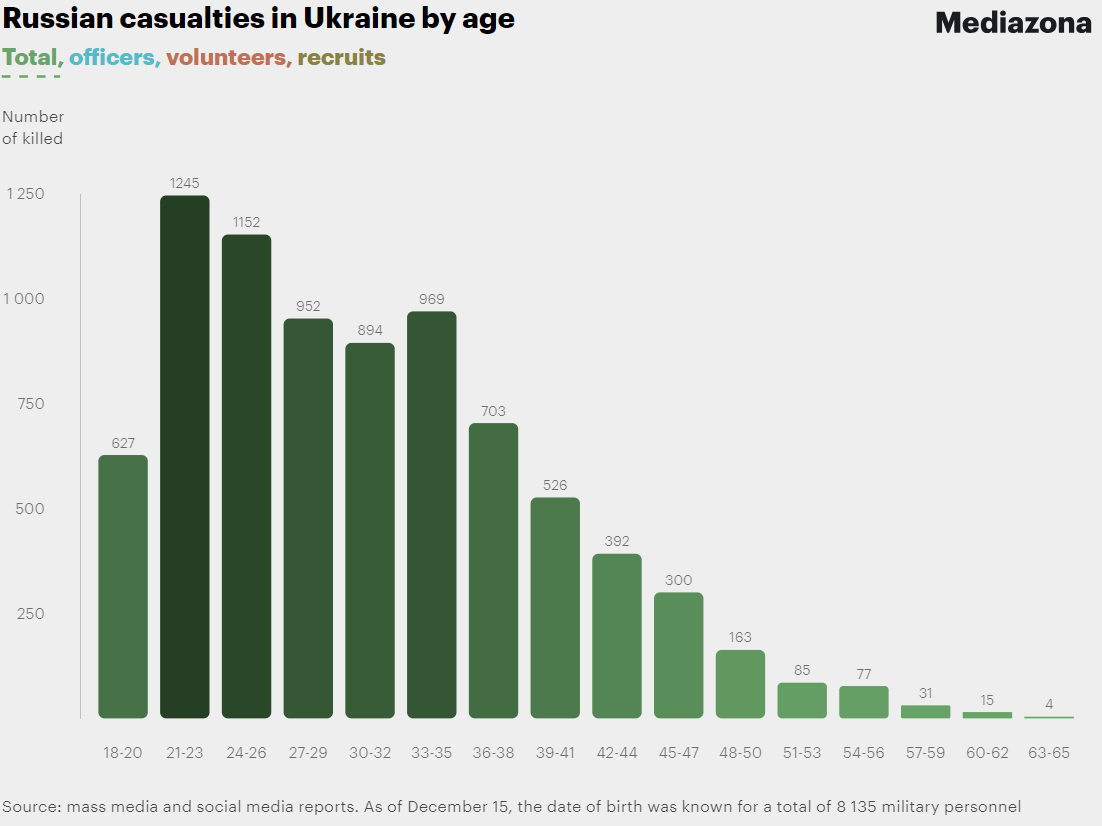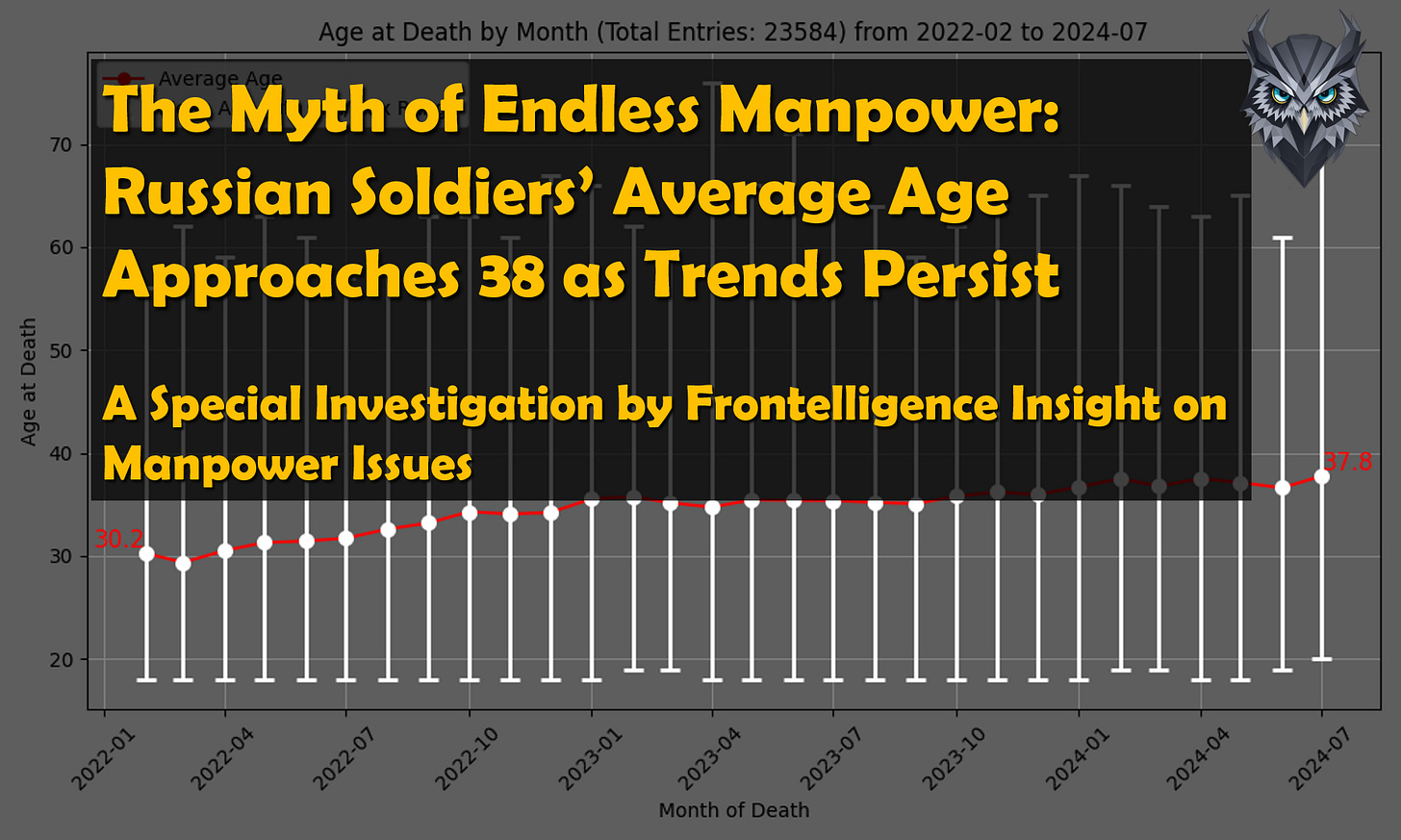The Myth of Endless Manpower: Russian Soldiers’ Average Age Approaches 38 as Trends Persist
A Special Investigation by Frontelligence Insight on Manpower Issues
When Russian forces make gains in Eastern Ukraine, these successes are often attributed to factors such as numerical advantage in vehicles, artillery, and manpower, along with a stronger recruitment situation in Russia compared to Ukraine. This creates the perception that Ukraine is uniquely struggling with manpower shortages and that Russia has a seemingly endless pool of manpower reserves. However, our recent research uncovers growing recruitment challenges in Russia, affecting both the quantity and quality of recruits. Our findings indicate that the average age of Russians killed in Ukraine is approaching 38 and continues to rise. This might have serious implications on the battlefield and the course of war, which we are discussing in today’s report.
Contents
I. What We Know About Recruitment Numbers So Far
II. Average Age of Killed Servicemembers Approaches 38
III. Implications and Conclusions
Data, Errors, and Sources
I. What We Know About Recruitment Numbers So Far

According to an investigation by the Conflict Intelligence Team and iStories, 345,400 one-time payments were made for signing contracts with the Russian Ministry of Defense in 2023. This averages to approximately 28,783 payments per month, a figure closely aligned with the 30,000 monthly recruits reported by the Ukrainian intelligence directorate GUR.
As of August 1, Russian contract signers began receiving almost doubled one-time federal payments of 400,000 rubles, along with additional payments from regional authorities. In some areas, such as Moscow, these combined payments can total nearly two million rubles.
The ongoing increase in payments is likely intended to address recruitment issues and meet pre-determined quotas. Previously, our team reported a deterioration in the quality of Russian recruits, although much of the evidence was anecdotal, based on testimonies from POWs captured on the frontlines. To provide more statistical data, we have now analyzed open-source information, primarily from obituary posts on Russian social media.
II. Average Age of Killed Servicemembers Approaches 38
According to our findings, between February 2022 and May 2024, the average age of Russian soldiers killed in action increased from 30.2 in early 2022 to 37.8 by July 2024.
To obtain this number, we analyzed a dataset comprising 23,548 records from Russian obituary posts on social media, which included both dates of birth and dates of death. The average age of those listed in obituaries seriously increased from the beginning of the war, with a notable surge after the second half of 2022. This correlates with the period of “partial mobilization” and the mass deployment of prisoners in the Soledar and Bakhmut operations by Wagner forces.
Before assessing the implications, we need to place the current situation in the context of other wars. To provide a meaningful comparison, we can look at the Vietnam War, given the reliable data available from that period.
According to the Combat Area Casualty File data from the Vietnam Helicopter Pilots Association, based on 58,148 death records, the average age of a U.S. servicemember killed in action during the Vietnam War was 23.11 years. It’s almost a 15-year age gap compared to the average age of Russian soldiers killed in Ukraine.

It’s almost a 15-year age gap compared to the average age of Russian soldiers killed in Ukraine.
III. Implications and Conclusions
This trend indicates that as the war continues, older recruits are increasingly being sent to the front lines, which signals serious problems that have a direct influence on the overall combat effectiveness of Russian forces. This raises questions about the sustainability of Russia's recruitment approach and the long-term viability of its war if the average age of its soldiers continues to rise.
The key point is that the individuals signing contracts come from civilian demographics, not from career military personnel who might regularly pass fitness tests. While precise data on the general fitness of these recruits is lacking, the World Health Organization reports that the pre-war life expectancy at birth for Russian males was 65.6 years, with a healthy life expectancy of 58.2 years.
This suggests that the Russian government not only has to offer significantly higher payments to recruit individuals but also ends up with recruits who may be less fit for combat roles, either partially or fully.
While the data presented may still contain some inaccuracies, errors, or potential duplicates, the trend is consistent with findings from other investigations and metrics reported by investigative groups, as well as with the anecdotal observations we reported earlier. Although Ukrainian demographics are anything but better than Russian ones, the extensive focus on Ukrainian manpower issues has fostered a perception that Ukraine is doomed due to seemingly endless Russian human resources and high recruitment numbers. Our research has demonstrated that this perception is misleading and indicates that Russia’s ability to conduct large-scale offensive operations with territorial gains, based on a manpower advantage, is not as sustainable as it seems in the long run.
Data, Errors, and Sources
The original dataset consists of nearly 65,000 records from the Poteru.net project, which gathers obituary posts from the Russian social media platform VK.com. The dataset is open-source and available for download and inspection.
We excluded and cleaned incomplete data, such as records missing dates of birth, that hindered accurate age determination of the deceased, which left us with 23,548 records. Despite these adjustments, the data remains consistent, and trends have not changed even as we incorporated additional records during multiple tries. This indicates that even if errors or duplicates make up 15% of the data, they are unlikely to significantly impact the results or conclusions of this research, as the trends continue to show a significant increase in age.
We also compared our dataset with the one from an investigation by Mediazona, which is more comprehensive and includes 52,541 records as of July 31, 2024.

The results were nearly identical, suggesting that despite having more than twice the number of records, the demographic picture remains consistent.
Furthermore, when compared to a similar graph from the end of 2022, the current demographic data shows a strikingly different picture. Such a stark contrast indirectly confirms the consistency of the data and the ongoing trend.

Our team compared our data with figures presented in May 2022 by the independent Russian investigative organization iStories. The average age of killed soldiers from February to May was 29 years, which overall aligns with our data for the same period. This consistency indicates that, while there may be some fluctuations as additional details and data become available, the overall age range remains stable and is likely accurate enough for reliable conclusions.







Great data ! Bravo
One fact that you did not mention in your post, is that young Russians have compulsory military service in their early 20s. It is forbidden by law to use these troops outside Russia, so none of them is sent to Ukraine. They may be stationed on the border of Ukraine in the defensive positions.
The fact that young Russians serve in the military in a completely different way from older Russians must have some impact on your findings. There is some evidence that commanders are trying to shame and bully conscripted young Russians into signing contracts at the end of their conscript service. How all this fits into the bigger picture of Russian military recruitment, I'm not quite sure, but it is part of the bigger picture.